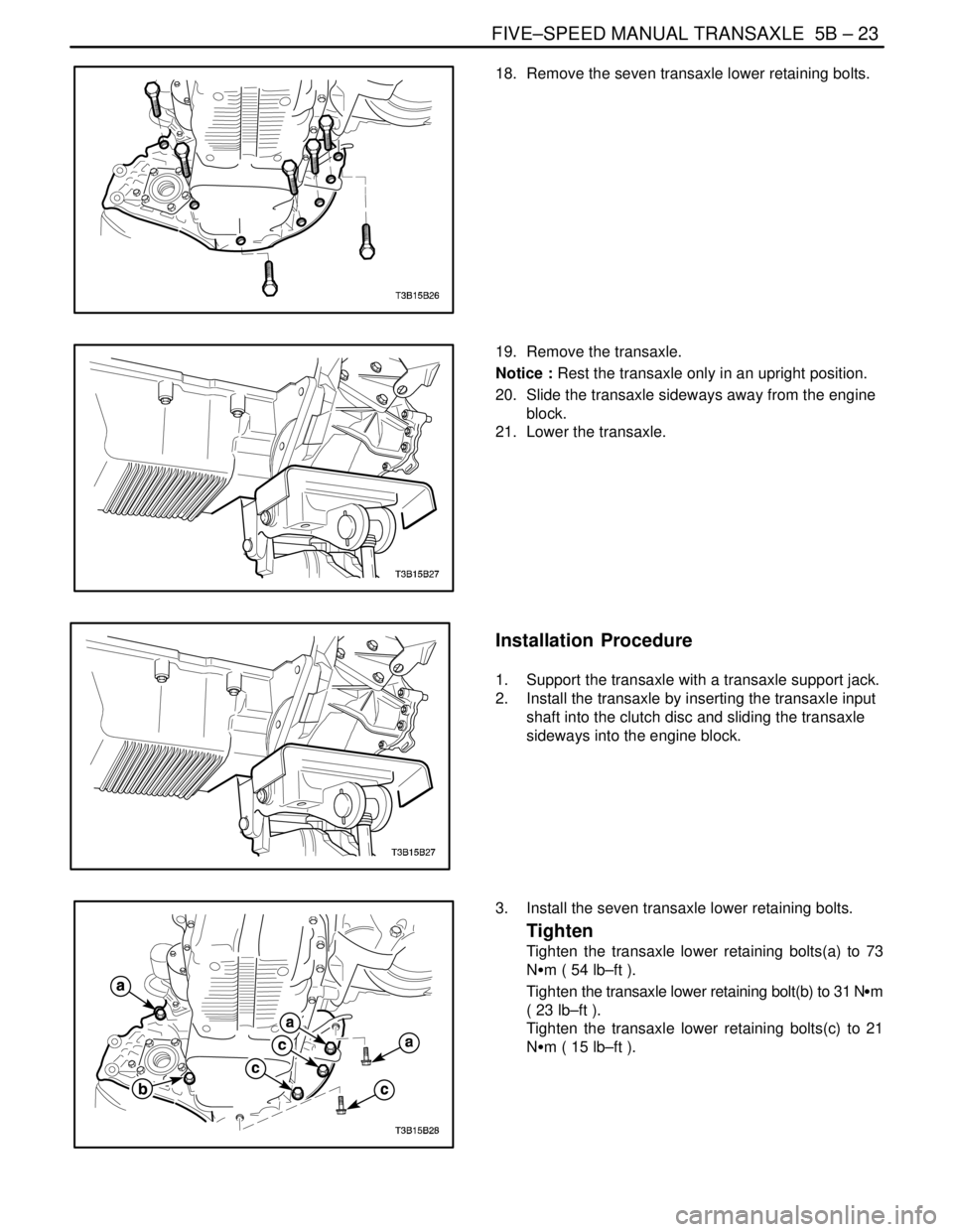Five speed manual transaxle clutch DAEWOO NUBIRA 2004 Service Repair Manual
[x] Cancel search | Manufacturer: DAEWOO, Model Year: 2004, Model line: NUBIRA, Model: DAEWOO NUBIRA 2004Pages: 2643, PDF Size: 80.54 MB
Page 5 of 2643

v
TABLE OF CONTENTS
Section 0B General Information
Section 1 Engine
Section 1A General Engine Information
Section 1C1 1.4L/1.6L DOHC Engine Mechanical
Section 1C2 1.8L DOHC Engine Mechanical
Section 1D Engine Cooling
Section 1E Engine Electrical
Section 1F Engine Controls
Section 1G Engine Exhaust
Section 2 Suspension
Section 2A Suspension Diagnosis
Section 2B Wheel Alignment
Section 2C Front Suspension
Section 2D Rear Suspension
Section 2E Tires and Wheels
Section 3 Driveline/Axle
Section 3A Automatic Transaxle Drive Axle
Section 3B Manual Transaxle Drive Axle
Section 4 Brakes
Section 4A Hydraulic Brakes
Section 4B Master Cylinder
Section 4C Power Booster
Section 4D Front Disc Brakes
Section 4E1 Rear Disc Brakes
Section 4E2 Rear Drum Brakes
Section 4F Antilock Brake System
Section 4G Parking Brake
Section 5 Transmission/Transaxle
Section 5A1 ZF 4HP16 Automatic Transaxle
Section 5A2 AISIN Automatic Transaxle
Section 5B Five-Speed Manual Transaxle
Section 5C Clutch
Section 6 Steering
Section 6A Power Steering System
Section 6B Power Steering PumpSection 6C Power Steering Gear
Section 6E Steering Wheel and Column
Section 7 Heating, Ventilation, and Air
Conditioning (HVAC)
Section 7A Heating and Ventilation System
Section 7B Manual Control Heating, Ventilation,
and Air Conditioning System
Section 7D Automatic Temperature Control HVAC
Section 8 Restraints
Section 8A Seat Belts
Section 8B Supplemental Inflatable Restraints
(SIR)
Section 9 Body and Accessories
Section 9A Body Wiring System
Section 9B Lighting Systems
Section 9C Horns
Section 9D Wipers/Washer Systems
Section 9E Instrumentation/Driver Information
Section 9F Audio Systems
Section 9G Interior Trim
Section 9H Seats
Section 9I Waterleaks
Section 9J Windnoise
Section 9K Squeaks and Rattles
Section 9L Glass and Mirrors
Section 9M Exterior Trim
Section 9N Frame and Underbody
Section 9O Bumpers and Fascias
Section 9P Doors
Section 9Q Roof
Section 9R Body Front End
Section 9S Body Rear End
Section 9T1 Remote Keyless Entry and Anti–Theft
System
Section 9T2 Immobilizer Anti–Theft System
Page 1826 of 2643

5B – 2IFIVE–SPEED MANUAL TRANSAXLE
DAEWOO V–121 BL4
SPECIFICATIONS
FASTENER TIGHTENING SPECIFICATIONS
ApplicationNSmLb–FtLb–In
Backup Lamp Switch2015–
Bearing Plate Bolts2216–
Bearing Retainer Bolts, Right Side2518–
Bearing–Adjusting Ring–Retainer Plate Bolt5–44
Clutch–Release Cylinder Retaining Bolts2015–
Damping Block Connection Nut and Bolt6850–
Differential Cover Bolts4030–
Fifth–Gear Fork Bolts2216–
Fifth–Gearshift Connector Bolts7–62
Flywheel Inspection Cover Bolts7–62
Gearshift Housing Bolts7–62
Gearshift Lever Cover Bolts2216–
Input Driveshaft Detent Screw1511–
Rear Damping Block Retaining Bolts6850–
Rear Mounting Bracket Bolts9066–
Ring–Gear Bolts7052–
Rod Clamp Bolt14–124
Speedometer Housing Retaining Bolt4–35
Speedometer–Driven Gear Bolt5–44
Transaxle Cover Bolts1813–
Transaxle Lower Retaining Bolts(a)7354–
Transaxle Lower Retaining Bolt(b)3123–
Transaxle Lower Retaining Bolts(c)2115–
Transaxle Upper Retaining Bolts7354–
Transaxle Upper Mounting Bracket Bolts4835–
Page 1829 of 2643

FIVE–SPEED MANUAL TRANSAXLE 5B – 5
DAEWOO V–121 BL4
DIAGNOSIS
ISOLATE NOISE
Identify the cause of any noise before attempting to repair
the clutch, the transaxle, or their related link–ages.
Symptoms of trouble with the clutch or the manual trans-
axle include:
S A great effort required to shift gears.
S The sound of gears clashing and grinding.
S Gear blockout.
Any of these conditions requires a careful analysis. Make
the following checks before disassembling the clutch or
the transaxle for repairs.
Road Travel Noise
Many noises that appear to come from the transaxle may
actually originate with other sources such as the:
S Tires.
S Road surfaces.
S Wheel bearings.
S Engine.
S Exhaust system.
These noises may vary according to the:
S Size of the vehicle.
S Type of the vehicle.
S Amount of insulation used in the body of the ve-
hicle.
Transaxle Noise
Transaxle gears, like any mechanical device, are not ab-
solutely quiet and will make some noise during normal op-
eration.
To verify suspected transaxle noises:
1. Select a smooth, level asphalt road to reduce tire
and resonant body noise.
2. Drive the vehicle far enough to warm up all the lu-
bricants thoroughly.
3. Record the speed and the gear range of the trans-
axle when the noise occurs.
4. Check for noises with the vehicle stopped, but with
the engine running.
5. Determine if the noise occurs while the vehicle op-
erates in:
S Drive – under a light acceleration or a heavy
pull.
S Float – maintaining a constant speed with a light
throttle on a level road.
S Coast – with the transaxle in gear and the
throttle partly or fully closed.
S All of the above.
Bearing Noise
Differential Side Bearing Noise
Differential side bearing noise and wheel bearing noise
can be confused easily. Since side bearings are pre–
loaded, a differential side bearing noise should not dimin-
ish much when the differential/transaxle is run with the
wheels off the ground.
Wheel Bearing Noise
Wheel bearings produce a rough growl or grating sound
that will continue when the vehicle is coasting and the
transaxle is in NEUTRAL. Since wheel bearings are not
pre–loaded, a wheel bearing noise should diminish con-
siderably when the wheels are off the ground.
Other Noise
Brinelling
A brinelled bearing causes a ”knock” or ”click” approxi-
mately every second revolution of the wheel because the
bearing rollers do not travel at the same speed as the
wheel. In operation, the effect is characterized by a low–
pitched noise.
A brinelled bearing is caused by excessive thrust which
pushes the balls up on the pathway and creates a triangu-
lar–shaped spot in the bearing race. A brinelled bearing
can also be caused from pressing one race into position
by applying pressure on the other race.
A false indication of a brinelled bearing occurs as a result
of vibration near the area where the bearing is mounted.
Brinelling is identified by slight indentations, resulting in a
washboard effect in the bearing race.
Lapping
Lapped bearing noise occurs when fine particles of abra-
sive materials such as scale, sand, or emery circulate
through the oil in the vehicle, causing the surfaces of the
roller and the race to wear away. Bearings that wear loose
but remain smooth, without spalling or pitting, are the re-
sult of dirty oil.
Locking
Large particles of foreign material wedged between the
roller and the race usually causes one of the races to turn,
creating noise from a locked bearing. Pre–loading regular
taper roller bearings to a value higher than that specified
also can result in locked bearings
Pitting
Pitting on the rolling surface comes from normal wear and
the introduction of foreign materials.
Spalling
Spalled bearings have flaked or pitted rollers or races
caused by an overload or an incorrect assembly that re-
sults in a misalignment, a cocking of bearings, or adjust-
ments that are too tight.
After completing these checks, refer to the ”Diagnosis
Chart” in this section.
Page 1830 of 2643

5B – 6IFIVE–SPEED MANUAL TRANSAXLE
DAEWOO V–121 BL4
SYMPTOM DIAGNOSIS
ChecksAction
Check for a knock at low speeds.S Replace any worn drive axle CV joints.
S Replace any worn side gear hub.
Check for a noise most pronounced on turns.S Correct any abnormalities in the differential gear.
Check for a clunk upon acceleration or deceleration.S Tighten any loose engine mounts.
S Replace any worn drive axle inboard joints.
S Replace any worn differential pinion shaft in the
case.
S Replace any worn side gear hub in the case.
Check for a clunking noise in turns.S Replace any worn outboard CV joint.
Check for a vibration.S Replace any rough wheel bearing.
S Replace any bent drive axle shaft.
S Replace any out–of–round tires.
S Balance any unbalanced tire.
S Replace any worn CV joint in the drive axle shaft.
S Correct an excessive drive axle angle by adjusting
the trim height.
Check for a noise in the NEUTRAL gear with the engine
running.S Replace any worn cluster bearing shaft.
S Replace any worn clutch–release bearing.
S Replace any worn input shaft cluster gears.
S Replace any worn first–gear/bearing.
S Replace any worn second–gear/bearing.
S Replace any worn third–gear/bearing.
S Replace any worn fourth–gear/bearing.
S Replace any worn fifth–gear/bearing.
S Replace any worn mainshaft bearings.
Check for a noise in the first gear (1) only.S Replace any chipped, scored, or worn first–gear
constant mesh gears.
S Replace any worn first–second gear synchronizer.
S Replace any worn first–gear/bearing.
S Replace any worn differential–gear/bearing.
S Replace any worn–ring gear.
S Adjust, repair, or replace the shift lever and the rods.
Check for a noise in the second gear (2) only.S Replace any chipped, scored, or worn second–gear
constant mesh gears.
S Replace any worn first–second gear synchronizer.
S Replace any worn second–gear/bearing.
S Replace any worn differential–gear/bearing.
S Replace any worn–ring gear.
S Adjust, repair, or replace the shift lever and the rods.
Check for a noise in the third gear (3) only.S Replace any chipped, scored, or worn third–gear
constant mesh gears.
S Replace any worn third–fourth gear synchronizer.
S Replace any worn third–gear/bearing.
S Replace any worn differential–gear/bearing.
S Replace any worn–ring gear.
S Adjust, repair, or replace the shift lever and the rods.
Page 1831 of 2643

FIVE–SPEED MANUAL TRANSAXLE 5B – 7
DAEWOO V–121 BL4
Checks Action
Check for a noise in the fourth gear (4) only.S Replace any chipped, scored, or worn fourth gear or
output gear.
S Replace any worn third–fourth gear synchronizer.
S Replace any worn fourth–gear/bearing.
S Replace any worn differential–gear/bearing.
S Replace any worn–ring gear.
S Adjust, repair, or replace the shift lever and the rods.
Check for a noise in the fifth gear (5) only.S Replace any chipped, scored, or worn fifth gear or
output gear.
S Repair any worn fifth–gear synchronizer.
S Replace any worn fifth–gear/bearing.
S Replace any worn differential–gear/bearing.
S Replace any worn–ring gear.
S Adjust, repair, or replace the shift lever and the rods.
Check for a noise in the reverse (R) gear only.S Replace any chipped, scored, or worn reverse idler
gear, idler–gear bushing, input gear, or output gear.
S Replace any worn first–second gear synchronizer.
S Replace any worn output gear.
S Replace any worn differential–gear/bearing.
S Replace any worn–ring gear.
Check for a noise in all gears.S Add sufficient lubricant.
S Replace any worn bearings.
S Replace any chipped, scored, or worn input–gear
shaft or output–gear shaft.
Check for the transaxle slipping out of gear.S Adjust or replace the linkage, as needed.
S Adjust, repair, or replace any binding shift linkage.
S Tighten or replace the input–gear bearing retainer, as
needed.
S Repair or replace any worn or bent shift fork.
Check for a leak in the area of the clutch.S Repair the transaxle casing.
S Replace any damaged release bearing guide.
Check for a leak at the center of the transaxle.S Repair the transaxle casing.
S Repair the shift mechanism.
S Replace the damaged backup lamp switch.
Check for a leak at the differential.S Adjust or replace the bearing retainers.
S Tighten or replace the differential cover.
S Adjust or replace the drive axle shaft seals.
Page 1832 of 2643

5B – 8IFIVE–SPEED MANUAL TRANSAXLE
DAEWOO V–121 BL4
Checks Action
Check for a hard shift.S Replace any damaged release–bearing guide.
S Adjust, repair, or replace the shift mechanism.
S Adjust, repair, or replace the clutch–release system.
S Replace any chipped, scored, or worn fifth–gear syn-
chronizer.
S Replace any chipped, scored, or worn first–second
gear synchronizer.
S Replace any worn third–fourth gear synchronizer.
S Adjust, repair, or replace the shift lever and the rods.
Check for a clashing of gears.S Replace any damaged release–bearing guide.
S Adjust, repair, or replace the clutch–release system.
S Replace the chipped, scored, or worn input shaft/
gear–cluster gears.
S Replace any worn fifth–gear synchronizer.
S Replace any worn fifth–gear/bearing.
S Replace any worn first–gear/bearing.
S Replace any worn first–second gear synchronizer.
S Replace any worn second–gear/bearing.
S Replace any worn third–gear/bearing.
S Replace any worn third–fourth synchronizer.
S Replace any worn fourth–gear/bearing.
S Replace any worn reverse–idler gear.
Page 1839 of 2643

FIVE–SPEED MANUAL TRANSAXLE 5B – 15
DAEWOO V–121 BL4
MAINTENANCE AND REPAIR
ON–VEHICLE SERVICE
CHECKING FLUID LEVEL
1. With the vehicle on a level surface and the fluid in
the transaxle cold, remove the filler plug and check
the fluid level. The fluid should come to the bottom
edge of the plug hole.
2. If the level is low, add SAE 80 manual transaxle
fluid through the filler plug hole until the fluid begins
to run out.
3. Reinstall the filler plug and tighten it securely.
4. If the fluid is contaminated, drain the oil after re-
moving the differential gear cover.
SHIFT LINKAGE ADJUSTMENT
(LEFT–HAND DRIVE SHOWN,
RIGHT–HAND DRIVE SIMILAR)
1. Disconnect the negative battery cable.
2. Position the gearshift lever into NEUTRAL.
Important : All the gears must be easy to engage when
the vehicle is stationary, the engine is running, and the
clutch is disengaged.
3. Loosen the rod clamp bolt.
Page 1845 of 2643

FIVE–SPEED MANUAL TRANSAXLE 5B – 21
DAEWOO V–121 BL4
TRANSAXLE ASSEMBLY
Tools Required
J–28467–B Engine Support Fixture
Removal Procedure
1. Install the engine support fixture J–28467–B.
2. Remove the battery and battery tray. Refer to Sec-
tion 1E, ENGINE ELETRICAL.
3. Remove the shift linkage assembly. Refer to ”Shift
Linkage Adjustment” in this section.
4. Remove the drive axle shaft. Refer to Section 3B,
Manual Transaxle Drive Axle.
5. Disconnect the backup lamp switch electrical con-
nector.
6. Disconnect the speedometer speed sensor electri-
cal connector.
7. Remove the pin and the clutch release cylinder
pipe.
8. Remove the damping block connection nut and
bolt.
9. Remove the three rear mounting bracket bolts.
10. Remove the rear mounting bracket from the trans-
axle.
Page 1847 of 2643

FIVE–SPEED MANUAL TRANSAXLE 5B – 23
DAEWOO V–121 BL4
18. Remove the seven transaxle lower retaining bolts.
19. Remove the transaxle.
Notice : Rest the transaxle only in an upright position.
20. Slide the transaxle sideways away from the engine
block.
21. Lower the transaxle.
Installation Procedure
1. Support the transaxle with a transaxle support jack.
2. Install the transaxle by inserting the transaxle input
shaft into the clutch disc and sliding the transaxle
sideways into the engine block.
3. Install the seven transaxle lower retaining bolts.
Tighten
Tighten the transaxle lower retaining bolts(a) to 73
NSm ( 54 lb–ft ).
Tighten the transaxle lower retaining bolt(b) to 31 NSm
( 23 lb–ft ).
Tighten the transaxle lower retaining bolts(c) to 21
NSm ( 15 lb–ft ).
Page 1849 of 2643

FIVE–SPEED MANUAL TRANSAXLE 5B – 25
DAEWOO V–121 BL4
11. Connect the clutch release cylinder pipe.
12. Connect the speedometer speed sensor electrical
connector.
13. Connect the backup lamp switch electrical connec-
tor.
14. Remove the engine support fixture J–28467–B.
15. Install the drive axle shaft. Refer to Section 3B,
Manual Transaxle Drive Axle.
16. Install the shift linkage assembly. Refer to ”Shift
Linkage Assembly” in this section.
17. Install the battery and battery tray. Refer to Section
1E, ENGINE ELETRICAL.
18. Inspect the fluid level. Refer to ”Checking Fluid Lev-
el” in this section.